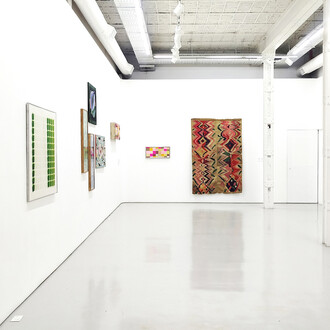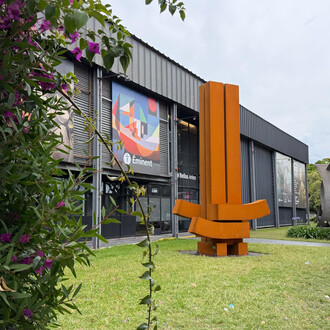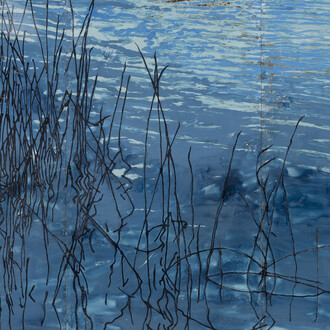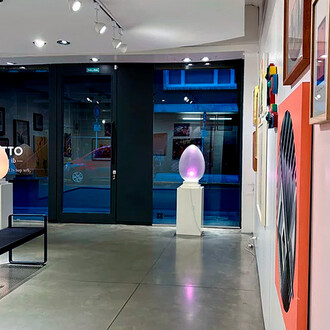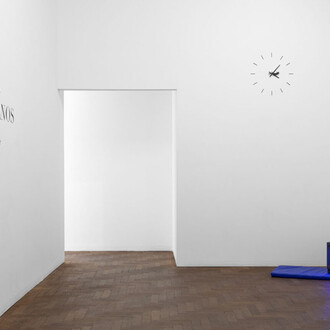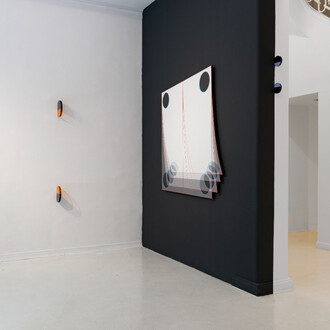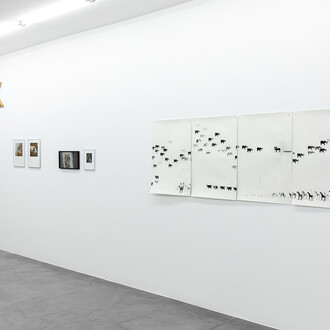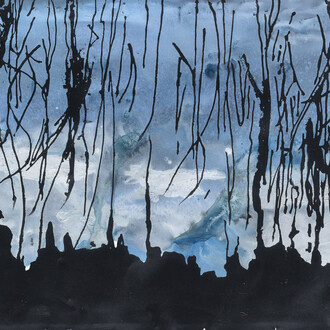“A pair of socks is no less fit for making a painting than wood, nails, turpentine, oil, and canvas.” The simple descriptive power of a statement by Robert Rauschenberg broadens what Laura Mema’s works point toward. Without any homogeneous stockpile, oil, canvas, and brush are replaced by tulle, cutter, scalpel, thread, and wool. The list responds less to a desire to demystify the pictorial vocabulary than to a need to incorporate materials that allow for additions.
For a certain pair of philosophers, each of them was already many. They explained it many times, and not only in their books. The “secrets of fabrication” of their writing fill prefaces and interviews, and in each case collaboration is presented as a material made up of hundreds of elements. In their community of ideas there is no room for duality: “It is the same to say: one is always alone, and one is always many. One is alone in a duo, and one is many when alone.” But let us not fear: the pronoun they choose is porous and does not designate an exclusive subject but a multitude. That is where their transformative drive lies.
Many times Laura Mema has referred in her work to bodies and species composed of plural, living, and not necessarily perceptible categories. Her practice questions the relationships and functions we establish with what is not visible. Laura is not interested in immediate experience but in what arises through another degree of perception. To register the energy channeled in a mineral, she drew based on the morphological structure of an amethyst and asked a pendulum which directions to take in order to continue the drawing of the hexagon. For some time she has been finding logical formulas to construct poetic images that appear accidental. This impulse—to present what cannot be seen through what can—led her to photograph different ocean floors and to contemplate the species inhabiting coral reefs as receivers of ancestral biological information.
Her latest pieces orbit around the song of the coyuyo (a type of cicada) which, though present globally, occupies a prominent place in northern Argentine culture. It is in the summer when the song of these creatures—whose vibration helps carob pods ripen—fills the entire region. But their song takes its time. When the egg hatches, the coyuyo larva falls from the tree where it was born and buries itself. It digs tunnels until it reaches the roots, whose sap it feeds on, and it can live underground between two and seventeen years, making its emergence unpredictable. The vibratory waves of its song are timeless, and the body’s memory of this sound transcends eras. Hearing it brings back the Santiago summer, and its presence—like that invoked by smell—does not respond to ocular evidence. Here, the perceptive sense is not governed by the eye. The song of the coyuyos promotes a listening attitude, whose effect Laura recovers in aesthetic terms. Paying attention to the sensory capacities guided by the ear has led her to discover cymatics plates to visualize the effects that sound waves produce on a surface. Through organic and symmetrical patterns, the sound of the coyuyos emerges on the plate, revealing to us the inner engineering of their vibrations.
From those lines and circles, Laura creates a series of colorful drawings using paper, acrylic, and tulle—a material whose hypnotic and compositional qualities have allowed her to establish a continuity between form and content. “Its materiality,” she explains, “has that abyssal aspect, it is a transparent body that generates volume. Tulle has something of a veil, it covers but at the same time lets you see. This multiple and simultaneous existence ends up becoming part of the web of systemic and biological logics in which we live.”
The interest in this formal expansion does not respond so much to a desire to demystify the pictorial vocabulary as to the need to incorporate materials that allow for new contemplative states. And in the case of Tinkunakuy, the stockpile responds to the interest in developing lines of work that can be produced by other participants. With the intention of generating a structure of exchange and an experience that is both individual and collective, Laura invited a group of weavers from the Santiago forest to transcribe into a series of textile works the patterns obtained from visualizing the sound of the coyuyos. The blankets were made using loom and traditional embroidery techniques, a kind of practice initiated by native peoples in pre-Hispanic times and continued by a small group of weavers over five generations. The threads of each of these works were dyed with vegetable and mineral dyes. The pigments, obtained in the Souk des Teinturiers (Dyers’ Market) of Marrakech and fixed to the wool in the Santiago forest, are extracts of poppy, turquoise, mint, saffron, turmeric, strawberry, henna, or violet. A metonymic process and an exercise in transmutation, through which each of these natural symbols is presented as elements of a possible rebirth.
Observing them in detail does not imply obtaining any kind of decipherment; however, they allow us to wonder about the colors of the places we visit when we daydream.
Artistic practice allows a material to condense an exercise in synthesis. Weaving is an expressive tool capable of absorbing and materializing emotions, transmitted over the years by those who practice it. Through hands, fingers, and nails, touch extends through the body. Now, let us think for a moment of weaving as a kind of touch that listens to what is happening. Those voices remain, and those voices build memory. That is why, in weaving, stories endure. That is also why, for those communities built around textile traditions, the expressive capacity of their craft transcends ornament.
Through reflections related to the Anthropocene, we know that the human species has colonized its natural environment. But the theory not only marks the entrance into a new geological era—characterized by the understanding of the impact of a specific species on the cycles that once guaranteed the planet’s habitability—it is also a way of naming an era of collective care. Laura does not seek to inform, in a vertical sense, about a problem but to offer a material field of action from which to intervene with excitement and gentleness.
In this creative attempt to dismantle the ideology of the self, to configure works that speak of a plural that does not separate culture and nature, what emerges are frameworks to rethink our relationship with others—understood as living species and not as human primacy. Laura allows us to revisit ancient behaviors through a sensory vocabulary that speaks to our subjective and communal needs.
(Text by Mariano Mayer)





